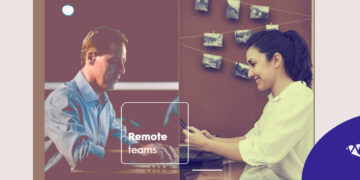The landscape of work has undergone a significant transformation, with remote work becoming not just a temporary adjustment but a permanent fixture for many organizations worldwide. This shift has brought about new challenges and opportunities in how teams communicate, collaborate, and maintain cohesion.
The dynamics of team interaction have evolved, necessitating a reimagining of team building for the digital era. In this context, technology emerges as the linchpin in creating a connected workspace that bridges the physical distance between team members.
By leveraging a suite of digital tools and innovative strategies, teams can foster a sense of belonging and collaboration, ensuring productivity and engagement in a remote setting.
This post addresses essential technologies and methodologies that facilitate remote team building, including communication platforms, collaborative tools, and virtual team-building activities, aiming to equip leaders and team members with the knowledge to thrive in a connected workspace.
The Connected Workspace
A connected workspace in the realm of remote work transcends the traditional office environment, encapsulating a digital ecosystem that allow team members to interact, collaborate, and contribute from any location.
At its core, this virtual space is designed to replicate the immediacy and fluidity of in-person collaboration, relying heavily on technology to bridge the gap between physical distances. The essence of a connected workspace is not merely in the tools it employs but in how it fosters a culture of openness, accessibility, and real-time communication among remote team members.
The backbone of this digital ecosystem is a robust technological infrastructure, which is paramount for the seamless operation of a connected workspace. High-speed internet connectivity forms the lifeline of remote work, ensuring that team members can communicate without delays and access cloud-based resources efficiently.
Equally important is the security of these connections. With the increasing reliance on digital platforms, securing data and communication channels against cyber threats has become a top priority. A secure and reliable infrastructure not only facilitates smooth operations but also instills confidence among team members regarding the safety of their work and personal information.
At the heart of the connected workspace are the communication platforms that serve as the virtual equivalent of an office’s hallways and meeting rooms. Tools like Slack and Microsoft Teams have become indispensable in the remote work toolkit, offering features that go beyond simple messaging to include video calls, file sharing, and integration with other productivity tools.
These platforms are designed to mimic the fluidity of real-life interactions, allowing for spontaneous conversations, scheduled meetings, and collaborative work sessions. Slack, with its channel-based structure, enables teams to organize discussions around specific projects or topics, ensuring that conversations remain focused and relevant.
Microsoft Teams, on the other hand, integrates deeply with the Microsoft Office suite, making it a powerful hub for collaboration that leverages familiar tools like Word, Excel, and PowerPoint. Together, these platforms lay the groundwork for a connected workspace, enabling teams to maintain a sense of proximity and cohesion despite the physical distances that separate them.
Communication Tools for Daily Interactions
In a connected workspace, communication tools play a pivotal role in ensuring that daily interactions among remote team members are as effective and personal as possible. Video conferencing tools like Zoom and Google Meet stand out for their critical role in facilitating face-to-face communication, a key component in maintaining team cohesion and understanding.
Zoom, for example, offers a range of features designed to support dynamic team meetings and one-on-one check-ins, including high-definition video and audio, screen sharing capabilities, and the option to record meetings for later reference. These features not only allow clear communication but also foster a sense of presence among team members, bridging the gap imposed by remote work.
Google Meet provides a secure and reliable platform for video calls, integrating seamlessly with other Google Workspace tools to facilitate easy access to meetings directly from the calendar or email invitations. The simplicity and accessibility of Google Meet make it an excellent choice for teams looking for straightforward and effective video conferencing solutions.
Beyond video calls, the organization of tasks and projects is another critical aspect of remote team collaboration. Project management software like Asana and Trello offers robust solutions to keep team members aligned on their responsibilities, deadlines, and progress. Asana allows for detailed task assignments and project timelines, providing a clear overview of who is working on what and by when tasks are due.
Its interface supports the creation of project roadmaps, making it easier to visualize the sequence of tasks and their dependencies. Trello, with its Kanban-style boards, is particularly useful for teams that benefit from a visual representation of their projects.
It allows team members to move tasks across different stages of completion, offering a dynamic and flexible approach to project management. Both platforms support integrations with a wide range of other tools, enhancing their utility and adaptability to various workflows.
The integration of video conferencing tools with project management software creates a seamless communication flow that is essential for the success of remote teams. This combination ensures that team members are not only aligned on their tasks but also have the means to discuss and collaborate on them in a manner that closely mimics in-person interactions.
Building Team Culture in a Virtual Environment
Building a positive team culture in a virtual environment requires thoughtful use of technology to replicate the camaraderie and connection found in physical office settings. The role of technology in this endeavor is multifaceted, serving not only as a bridge for communication but also as a tool for fostering shared experiences, celebrating achievements, and building relationships among remote team members.
One of the most effective ways to cultivate a sense of belonging and teamwork online is through virtual team-building activities. These activities, facilitated by technology, can range from simple online games that encourage collaboration and problem-solving to virtual happy hours where team members can unwind and socialize in a less formal setting.
Online platforms like Jackbox Games or Kahoot! offer a variety of games that teams can play together, promoting not only fun but also teamwork and communication skills. Similarly, organizing virtual happy hours or coffee breaks via video conferencing tools allows team members to share personal stories and interests, fostering deeper connections and understanding among colleagues.
These activities help break down the isolation that can sometimes accompany remote work, ensuring that team members feel part of a cohesive and supportive community.
In addition to team-building activities, technology plays a crucial role in recognizing and celebrating the achievements and milestones of team members. Employee recognition platforms offer innovative ways to acknowledge individual and team successes, reinforcing a culture of appreciation and positive reinforcement.
These platforms allow team members to give and receive real-time feedback and recognition, often accompanied by tangible rewards or points that can be redeemed for gifts.
This instant and public recognition can boost morale and motivation, making team members feel valued for their contributions. Celebrating milestones, whether work-related achievements or personal events like birthdays and work anniversaries, can also be facilitated through these platforms, ensuring that no achievement or special moment goes unnoticed.
Check this video if you want to learn more about team building activities!
Takeaway
The transformation of the workplace into a digital domain necessitates innovative approaches to foster team cohesion and culture, a challenge that technology has risen to meet with remarkable efficacy.
Through the strategic deployment of communication platforms, project management tools, and virtual team-building activities, companies are capable of crafting a connected workspace that not only supports but enhances the dynamics of team interaction in a remote setting.
This digital evolution enables teams to maintain a sense of belonging, ensure productivity, and foster a positive team culture, overcoming the physical barriers of remote work. As we navigate this new era, the integration of these technologies and methodologies stands as a testament to the adaptability and resilience of teams worldwide, ensuring that distance is no longer a barrier to effective collaboration and team unity.














